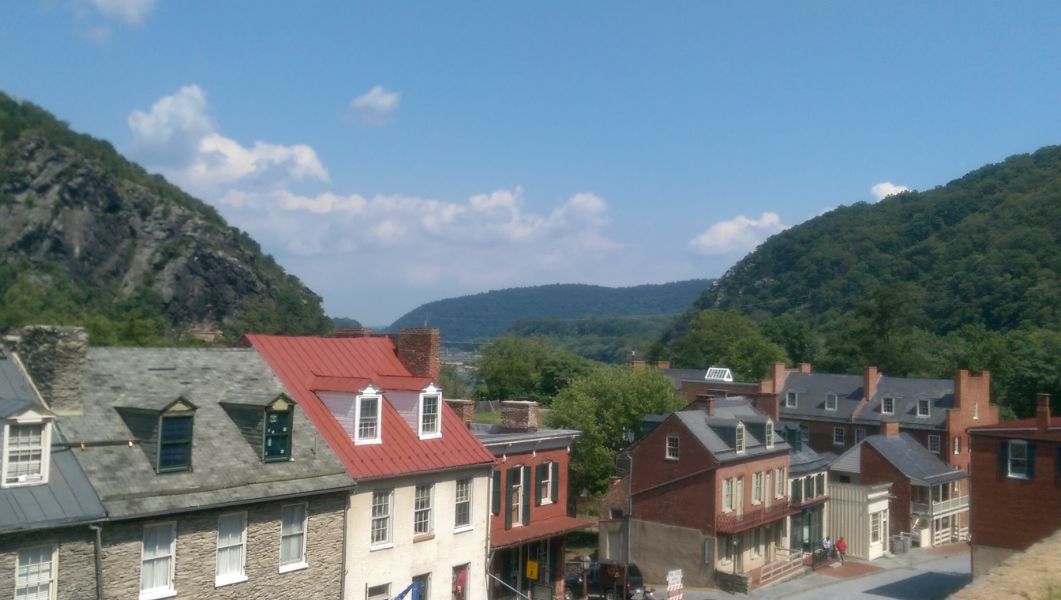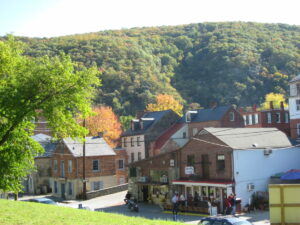Front Royal, VA. Recently, I visited the town of Harpers Ferry, which is part residence, part business, part National Historic Park. Harpers Ferry is not so much nestled in the mountains as it is part of the mountain; unlike the landscape a mere mile or two away, there are no rolling hills or green pastures here. Instead, the houses, shops, and stairways are either built upon, into, or from the rock, with steps carved into the mountain and the average backyard not so much teetering upon as already falling off the cliffs.
There are many layers to visiting Harpers Ferry, the site of John Brown’s famous (or infamous, depending on your perspective) 1859 raid on the U.S. Armory there, which helped precipitate the Civil War. It is a place deeply resonant with memory, pain, hope and, oddly enough, signs advertising CBD. Maybe because of all the hikers coming off the Appalachian Trail.
But what I want to talk about is the mountain goats.
Not the actual goat kind. No. I mean the other kind of kid. The children, the ones who have been running up and down those terrifically uneven stairwells cut into the rock since Harper and his ferry first came to the area in 1830. The ones whose current playsets are placed precariously two feet from a rotting cliffside fence that somehow, most incredibly, has not yet been smashed to pieces by one preschooler flinging another into it with the full force of toddler justice.
Those oddly invisible children.
Who were the first of these, those mountain goats of the nineteenth century? I imagine a childhood lived on those rock faces. Hardscrabble almost always, and surely smoky with the refuse of the pulp, weapon, and other factories. Iron ore was mined there, and the chimneys and railroad belched their tobacco-y perfume into that little town at the confluence of the Shenandoah and Potomac rivers, even though the wind may sometimes have blown it away. Just before the Civil War, the town boasted a thriving population of around 3,000, but by mid-war it had only 100 remaining residents, according to the National Park signage. Although a slave-owning town, it joined the Union in 1863 as part of the new state of West Virginia. And yet it was as devastated by warfare as any Confederate hamlet in the nearby Shenandoah Valley of Virginia.
So I imagine the pinafored little girls and the rough-and-tumble boys, the town children and the farm children, the children living above the bakery with their widowed father, their father soon to be shot and killed in the street by Brown’s men and they themselves turned out of the house by Union requisitioners. And the other children who wore no clean pinafores but always did what they were told, small enslaved children also running up and down the rock mountain. In a historical tailor’s shop in town I was shown an outfit representing that worn by an enslaved person. It was thick, strong, clean, and new. It was not representative.
And then I see the evidence of children there today. I see evidence of children, but not a single local child do I see, although it is the weekend and the weather is unusually fine. Most of them, of course, do not live in what is called the “lower town,” where the historic sites stand, but I do not see them in the rest of town, either. I see their empty playgrounds, their woeful daycare buildings, and their dilapidated, once-gracious homes. I do see a few real live children in the historic Catholic church at Mass on Sunday morning, but they are obviously not climbing anything in that context.
Although, on the other hand, my own toddlers have certainly climbed me during church before.
What is it like, then, to be a mountain goat in Harpers Ferry today? For when I think about those earlier children, I note that although their lives were characterized by hardship and even trauma, and many of them saw and experienced things no child should ever know, still, they had the mountain to rest their eyes against, to paraphrase Ernest Smith, and the freedom to be a part of the town and the landscape and its life. Pictures show them running through the muddy street, smiling. There were good things along with the bad—though for the enslaved children, how much any good weighed, I will never know.
Today we provide our children with better toothpaste, more frequent baths, cleaner clothes, more effective medicine, longer schooling, and certain freedoms from labor and abuse that children in the nineteenth century did not, as a rule, possess. And yet the children of Harpers Ferry today do not get to be mountain goats. Something—school, day care, iPads, car culture, custom, obesity, parental anxiety, whatever—is keeping them inside. They are nowhere to be seen, except, I presume, in the schools and inside their parents’ cars. For how can that rotting fence right beside the playhouse truly have survived anyone’s childhood? Is it that the children simply never play against it—or hardly even go outside at all?
I can’t claim to know what it is like to be a West Virginian child today, and I don’t mean to pick on a particular place. I know from my reading that many West Virginians still have a keen attachment to place and landscape and, to some degree, Appalachian traditions of hunting, music, farming, and home arts. I am sure many children there live healthy, even free lives. My own mother grew up in this Appalachian tradition and yet, when I take my children back to our ancestral home place in Georgia, I am not sure how free to let my children be. In part this is because that mountain place, too, like Harpers Ferry, has become a tourist town, and now we have replaced known dangers such as the railroad and the rapids with unknown ones posed by strangers.
Although come to think of it, John Brown’s Raid was brought to Harpers Ferry by strangers, too.
My own town in Virginia has more mountain goats than average, but still too few. When my children go outside they are often the only ones. But then, sometimes the neighbor kids are out playing, and sometimes a boy or two is fishing illegally in the nearby pond. And many families I know who have acreage outside of town encourage their children to play and work outdoors.
But how common is this? How many of our children who ought to be mountain goats simply are not?
I long to be a mountain goat still myself, and I want my children to be such, too, even though I do not idealize the past. When we think of some mythic time in American history when childhood was ideal, we fool ourselves (see Stephen Mintz’s book on the subject, for starters) and do no good to anyone. But for those of us seeking attachment to place, appreciation of landscape, outdoor living, freedom from overuse of digital technology, and the space to think, serve, and be together: I hope we can raise mountain goat children.
We should not reject the good fruits of our modern era, but let us also not neglect the good it does young bodies and minds to run up and down the cliffs, to have a mountain to rest the eyes against, and to sometimes simply be outside without parental interference. Let’s not be afraid to let them run, to give them the freedom to really get to know the yard, the town (when reasonable), and the creek at the park. It doesn’t matter that it’s not the done thing, that it is the scary thing, that it is the thing that makes us weep over laundry baskets overflowing with muddy kid clothes. For when coupled with good parental attention and care, it is also the wise thing to do: the thing that creates strong, sturdy, adventurous children.
And then let’s make them brush their teeth and take a bath, too.
Image Credit: Harper’s Ferry, WV





